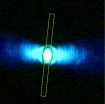(Press-News.org) LIVERMORE, Calif. - Lawrence Livermore National Laboratory researchers have developed an efficient method to measure residual stress in metal parts produced by powder-bed fusion additive manufacturing.
This 3D printing process produces metal parts layer by layer using a high-energy laser beam to fuse metal powder particles. When each layer is complete, the build platform moves downward by the thickness of one layer, and a new powder layer is spread on the previous layer.
While this process is able to produce quality parts and components, residual stress is a major problem during the fabrication process. That's because large temperature changes near the last melt spot - rapid heating and cooling - and the repetition of this process result in localized expansion and contraction, factors that cause residual stress.
Aside from their potential impact on mechanical performance and structural integrity, residual stresses may cause distortions during processing resulting in a loss of net shape, detachment from support structures and, potentially, the failure of additively manufacturing (AM) parts and components.
An LLNL research team, led by engineer Amanda Wu, has developed an accurate residual stress measurement method that combines traditional stress-relieving methods (destructive analysis) with modern technology: digital image correlation (DIC). This process is able to provide fast and accurate measurements of surface-level residual stresses in AM parts.
The team used DIC to produce a set of quantified residual stress data for AM, exploring laser parameters. DIC is a cost-effective, image analysis method in which a dual camera setup is used to photograph an AM part once before it's removed from the build plate for analysis and once after. The part is imaged, removed and then re-imaged to measure the external residual stress.
In a part with no residual stresses, the two sections should fit together perfectly and no surface distortion will occur. In AM parts, residual stresses cause the parts to distort close to the cut interface. The deformation is measured by digitally comparing images of the parts or components before and after removal. A black and white speckle pattern is applied to the AM parts, so that the images can be fed into a software program that produces digital illustrations of high to low distortion areas on the part's surface.
In order to validate their results from DIC, the team collaborated with Los Alamos National Laboratory (LANL) to perform a residual stress test using a method known as neutron diffraction (ND). This technique, performed by LANL researcher Donald Brown, measures residual stresses deep within a material by detecting the diffraction of an incident neutron beam. The diffracted beam of neutrons enables the detection of changes in atomic lattice spacing due to stress.
Although it's highly accurate, ND is rarely used to measure residual stress because there are only three federal research labs in the U.S. - LANL being one of them - that have the high-energy neutron source required for this analysis.
The LLNL team's DIC results were validated by the ND experiments, showing that DIC is a reliable way to measure residual stress in powder-bed fusion AM parts.
Their findings were the first to provide quantitative data showing internal residual stress distributions in AM parts as a function of laser power and speed. The team demonstrated that reducing the laser scan vector length instead of using a continuous laser scan regulates temperature changes during processing to reduce residual stress. Furthermore, the results show that rotating the laser scan vector relative to the AM part's largest dimension also helps reduce residual stress. The team's results confirm qualitative data from other researchers that reached the same conclusion.
By using DIC, the team was able to produce reliable quantitative data that will enable AM researchers to optimally calibrate process parameters to reduce residual stress during fabrication. Laser settings (power and speed) and scanning parameters (pattern, orientation angle and overlaps) can be adjusted to produce more reliable parts. Furthermore, DIC allowed the Lawrence Livermore team to evaluate the coupled effects of laser power and speed, and to observe a potentially beneficial effect of subsurface layer heating on residual stress development.
"We took time to do a systematic study of residual stresses that allowed us to measure things that were not quantified before," Wu said. "Being able to calibrate our AM parameters for residual stress minimization is critical."
LLNL's findings will eventually be used to help qualify properties of metal parts built using the powder-bed fusion AM process. The team's research helps build on other qualification processes designed at LLNL to improve quality and performance of 3D printed parts and components.
INFORMATION:
Wu and her colleagues are part of LLNL's Accelerated Certification of Additively Manufactured Metals (ACAMM) Strategic Initiative (acamm.llnl.gov). The other members of the Lawrence Livermore team include Wayne King, Gilbert Gallegos and Mukul Kumar.
The team's results were reported in an article titled "An experimental investigation into additive manufacturing-induced residual stresses in 316L stainless steel" that was recently published in the journal Metallurgical and Materials Transactions.
Founded in 1952, Lawrence Livermore National Laboratory provides solutions to our nation's most important national security challenges through innovative science, engineering and technology. Lawrence Livermore National Laboratory is managed by Lawrence Livermore National Security, LLC for the U.S. Department of Energy's National Nuclear Security Administration.
The race to make computer components smaller and faster and use less power is pushing the limits of the properties of electrons in a material. Photonic systems could eventually replace electronic ones, but the fundamentals of computation, mixing two inputs into a single output, currently require too much space and power when done with light.
Researchers at the University of Pennsylvania have engineered a nanowire system that could pave the way for this ability, combining two light waves to produce a third with a different frequency and using an optical cavity to amplify ...
Rice University scientists have invented a novel cathode that may make cheap, flexible dye-sensitized solar cells practical.
The Rice lab of materials scientist Jun Lou created the new cathode, one of the two electrodes in batteries, from nanotubes that are seamlessly bonded to graphene and replaces the expensive and brittle platinum-based materials often used in earlier versions.
The discovery was reported online in the Royal Society of Chemistry's Journal of Materials Chemistry A.
Dye-sensitized solar cells have been in development since 1988 and have been the subject ...
Scientists using a microbe that occurs naturally in eastern cottonwood trees have boosted the ability of two other plants - willow and lawn grass - to withstand the withering effects of the nasty industrial pollutant phenanthrene and take up 25 to 40 percent more of the pollutant than untreated plants.
The approach could avoid the regulatory hurdles imposed on transgenic plants - plants with genes inserted from or exchanged with other plant or animal species - that have shown promise in phytoremediation, the process of using plants to remove toxins from contaminated sites, ...
More than a decade ago, researchers from Brigham and Women's Hospital (BWH) demonstrated that a high dose statin, which lowered cholesterol further than a regular dose statin, provided better clinical outcomes. But questions remained about whether further reducing cholesterol would be even more effective in reducing cardiovascular-related events.
Now, results of the highly anticipated IMProved Reduction of Outcomes: Vytorin Efficacy International Trial (IMPROVE-IT), co-led by researchers at BWH and Duke Medicine, indicate that adding a second drug, ezetimibe, that blocks ...
WCS, NASA, And other conservation and remote sensing agencies, universities and NGOs focus on top 10 conservation questions for satellite technology
Remote sensing has and can continue to play a critical role in conserving Earth's biological diversity
Protected area management is a key use of remote sensing data
Newly formed Conservation Remote Sensing Network to apply remote sensing data to conservation challenges
NEW YORK (November 17, 2014)--Scientists from the WCS (Wildlife Conservation Society), NASA, and other organizations have partnered to focus global attention ...
Harvard Stem Cell Institute (HSCI) researchers, representing five Harvard departments and affiliated institutions as well as the Massachusetts Institute of Technology (MIT), have demonstrated that adult cells, reprogrammed into another cell type in a living animal, can remain functional over a long period.
The work by Joe Zhou, an associate professor in Harvard's Department of Stem Cell and Regenerative Biology, and his collaborators is an important advance in the effort to develop cell-based therapies for tissue repair, and specifically in the effort to develop improved ...
HOUSTON - (Nov. 17, 2014) - Offering small financial incentives doubles smoking cessation rates among socioeconomically disadvantaged smokers, according to research from The University of Texas Health Science Center at Houston (UTHealth). The findings were published last week in the American Journal of Public Health.
Tobacco use is the leading cause of preventable death in the United States, according to the Centers for Disease Control and Prevention. Thanks to public health efforts, smoking rates have declined to 18 percent among American adults. However, nearly 30 percent ...
If your surname reveals that you descended from the "in" crowd in the England of 1066--the Norman Conquerors--then even now you are more likely than the average Brit to be upper class. To a surprising degree, the social status of your ancestors many generations in the past still exerts an influence on your life chances, say Gregory Clark of the University of California, Davis, in the US and Neil Cummins of the London School of Economics in the UK. They used the Oxbridge attendance of people with rare English surnames (last names) to track social mobility from 1170 to 2012. ...
(NEW YORK - November 17) Brief usage of the painkiller oxycodone may impair behavioral flexibility even after that use ends, suggesting impaired decision-making as an enduring consequence of exposure, according to a study conducted at the Icahn School of Medicine at Mount Sinai and published November 17 in the journal Learning and Memory.
The Mount Sinai study investigated behavioral flexibility, the ability to select new responses when otherwise familiar circumstances change. In people and rodents exposed to drugs of addiction, repeated actions can become automated ...
Raptors, or birds of prey, some of which are endangered species, typically live in environments that provide natural land cover, such as forests and grasslands. Protecting endangered raptor species helps maintain food chain balance and prevents overpopulation of common raptor prey, such as snakes and rodents. As more businesses are built on the edges of urban areas, land where raptors once lived becomes industrialized, which raises concerns about the consequences of habitat destruction on raptor populations. Now, University of Missouri researchers have found that businesses ...





